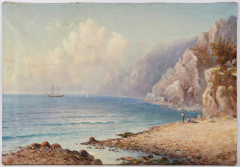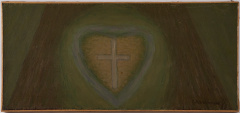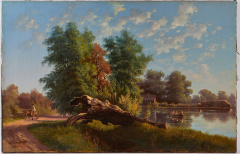Art Investment
Benois Alexandr Nikolaevich
1870–1960
БИОГРАФИЯ
BENOIS Alexander Nikolaevich
Painter, graphic artist, scene-designer, art historian, art critic
Alexander Benois came from an artistic and intellectual family; he was a son of the architect N. L. Benois, grandson of the architect A. K. Kavos, brother of the architect L. N. Benois and the aquarellist Al. N. Benois, the uncle of Russian artists Eugene Lanceray and Z. Serebriakova. Benois graduated from the private gymnasium of K. I. May. He got his art education mainly at home; in 1887 he took four-month studies at the evening classes of the Imperial Academy of Arts (IAKh). In 1890–1894 Benois studied at the faculty of law at St. Petersburg University. At the same time he studied watercolor technique under the guidance of his elder brother Albert. He participated in exhibitions of the Society of Russian Watercolorists (1893–1896, 1918), exhibition of Secession in Munich (1898). Since 1894 Benois supervised the Countess M. K. Tenisheva’s collection of drawings and watercolors.
In early 1890s Benois together with L. S. Bakst and E. E. Lanceray established a circle of self-education, which became the core of the future movement Mir Iskusstva (“World of Art”). Benois was one of the founders and ideologists of this society, a member of the editorial board and head of the retrospective department of the art magazine of the same name. Since 1899 he was a participant of the exhibitions of Mir Iskusstva. Since 1903 he became a member and exhibitor (1908–1910) of the Union of Russian Artists.
Benois taught history of styles in the Central School of Technical Drawing of Baron Alexander Stieglitz. He was an editor of the magazines Khudozhestvennye sokrovishcha Rossii (“Art Treasures of Russia”) and Starye gody (“Past Years”) in 1901–1903.
As an illustrator Benois designed the poem by Pushkin Mednij vsadnik (“The Bronze Horseman”), his own book Alphabet in Pictures by Alexander Benois, and created drawings for a set of cards Toys (1905). Benois was engaged in history of art; he wrote a book Russian School of Painting (1904); Tsarskoe Selo in the Reign of Empress Elizabeth (1910); The History of Painting of All Time (1912–1917, not finished).
Benois travelled throughout Europe; in 1890 he visited Germany, in 1894 — Switzerland, Italy, Austria, Poland, in 1899 — England. In 1896–1899 and 1905–1907 he lived in Paris.
Since 1900 he worked as a scene-designer, in particular he designed Cupid’s Revenge in the Hermitage Theatre in St. Petersburg. Benois collaborated with the Mariinsky theatre and Moscow Art Theatre. In 1907 he together with S. P. Diagilev headed the directorate which managed the organization of Russian Seasons in Paris, and since 1909 he headed the art department.
In 1914–1917 Benois headed the work on the interior painting of Kazan railway station in Moscow (not implemented). He was a member of the Commission of Art in St. Petersburg (March 1917).
After the October Revolution Benois became a member of the Committee for Protection of Art and Historical Memorabilia, the art and historical commission of the Winter Palace, the board of the art department of the Russian State Museum. Since 1918 he was a head of the art gallery Hermitage. In 1917–1918 Benois together with M. Gorky edited books for children for the Parus (“Sail”) publishing house. Benois headed the art department of the Vsemirnaya literatura (“World Literature”) publishing house. Since 1919 he was a member of the National Academy of History of Material Culture, and since 1921 Benois worked in the Russian Academy of Artistic Sciences. In 1919 he became a member of the directory which managed the affaires of the former Mariinsky Theatre. Benois collaborated with the Bolshoi Drama Theatre, the National Theatre and the State Academic Theatre of Drama (1920–1923) in Petrograd, the Diagilev’s enterprise, Grand Opera theatre, N. F. Baliev cabaret theatre Die Fledermaus (“The Bat”, 1923–1925) in Paris. Since 1925 he worked as a cinema artist.
In 1926 Alexander Benois refused to return to the Soviet Union from a business trip to Paris, which was arranged by the Hermitage. In Paris he worked a lot as a scene-designer. In 1926–1935 he was a chief artist of the ballet troupe of Ida Rubinstein. He was the designer of performances of the Comédie-Française, the private Russian Opera, the National Opera House in Paris, Diagilev’s Russian Ballet in Monte Carlo, the State Opera in Munich, Teaotro La Scala in Milan and others.
Benois was also engaged in easel painting and graphic art. He created watercolor landscapes of suburbs and parks of Paris, Normandy, Brittany in his manner of early 1900s. He painted landscapes of St. Petersburg and its surroundings, which he painted from memory, as well as works on Russian historical themes. He drew illustrations for the books The Sorrows of Young Werther by A. Maurois (1926), Sinner by A. de Regnier (1928), The Captain's Daughter by A. S. Pushkin (1944) and others.
Personal exhibitions of Benois were held in Paris (1926, 1929, 1940, and 1953), London (1937, 1939, and 1959) and Como (1955). Significant epistolary heritage was left after his death.
In 1960 retrospective exhibitions of the artist were organized in London and Milan. Retrospective exhibitions of Benois’ works were held in Milan (1970), Moscow (1970), Leningrad–St. Petersburg (1971, 1994), Kiev (1972) and London (1980).
Alexander Benois was one of the greatest masters of the Russian art of the first half of the 20th century, who created his own style in easel painting, graphic art, book illustration and scene design. The scope of his interests was rarely extensive and varied, and the basis of his artistic explorations was retrospective review, especially the history and art of the 18th century.
Benois used various techniques in his work: watercolor, gouache, pastel, oil, tempera, Indian ink, pencil. He often resorted to mixed techniques, seeking harmonious interplay between pictorial and graphic elements in a single work. The main features of Benois’ manner were fluency, incompleteness, accented texture of the stroke, acutefragmentary compositions, high or low points of view that allowed Benois to attain this special expressiveness and poetry.
Works by Alexander Benois are in many museum and private collections, including the State Russian Museum, the State Tretyakov Gallery and the Pushkin State Museum of Fine Arts.
Новости - Auctions
Торги «Антиквариума» 28 июля. Краткие итоги
03.08.2018Очередной аукцион #всёпорублю в «Литфонде» принес почти 4,5 млн.руб.
25.07.2018«Русская Эмаль» торжественно закрывает сезон и уходит в отпуск
24.07.2018Краткие итоги сороковых живописных торгов «Кабинета»
16.07.2018Коротко о главном: итоги аукциона 28 июня в «Литфонде»
03.07.2018Торги 27 июня в «Литфонде» для самых терпеливых и настойчивых
03.07.2018
Услуги ARTinvestment
Арт-консалтинг
Индивидуальные консультации от опытных искусствоведов по любым вопросам в сфере искусства
Составление Инвестиционного Портфеля
Подбор предметов искусства для инвестирования под любую инвестиционную стратегию
Индивидуальная оценка
Наши эксперты проведут профессиональную оценку вашего предмета искусства, учитывая его состояние, авторство, историю и другие факторы
Проведенных аукционов
Зарегистрированных пользователей на аукционе
Записей в базе
Художников в базе
Auction sale in AI Auction

КАПУСТИН Григорий Иванович (1865–1925) Крымский берег. Первая четверть XX века (49 × 71 см)
сделать ставку
ШАРШУН Сергей Иванович (1888–1975) Мистическое сердце. 1953 (20,7 × 44,8 см)
сделать ставку
КАМЕНЕВ Валериан Константинович (1823–1874) Пейзаж с поваленным деревом. 1870-е (52,5 × 80,2 см)
сделать ставку